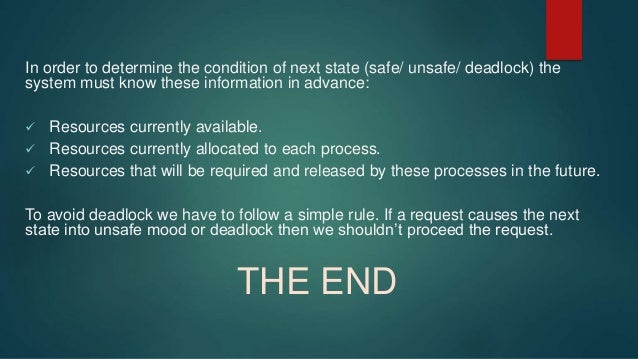

Modified priority based probe for distributed deadlock detection and resolution. An efficient deadlock avoidance technique. It also describes how we use this AND-OR deadlock prevention technique in a concurrent real-time system.īelik, F. This paper describes a general resource request condition that we prove prevents deadlock in AND-OR systems. Deadlock detection and recovery techniques and deadlock avoidance techniques typically involve preempting resources or terminating processes, and are therefore inappropriate for real-time systems that require the execution time of processes to be predictable. If locking is used to provide exclusive access to resources, deadlock is possible since processes can request additional resources while holding other resources.

As such, a concurrent real-time-process has AND-OR resource requirements. To provide predictable execution time required in real-time systems, a process also needs guaranteed access to at least one of a set of active resources (such as processors) associated with each passive resource. I am sharing with you some of the common comparison between starvation and deadlock.To meet consistency requirements found in concurrent applications, a process must be guaranteed that it will be able to use all resources in a set of passive resources (such as shared data structures). Operating system can increase the priority of a process based on its waiting time in the ready queue.ĭifference between starvation and deadlock
Aging is the possible solution of starvation. An independent and fair manager can be used for distribution of the resources. Avoid Random selection of processes to overcome the starvation. Some solutions that can be implemented in a system to handle the problem of starvation are mentioned below If there are not enough resources available to allocate to every process as required. If random selection of processes is used then a non-selected process may wait for a long time. Faulty resource allocation to the processes. A lower priority process may wait forever if higher priority processes constantly utilizing the required resource. Some of the common causes of starvation are mentioned below We need to allocate the resources efficiently and smartly to overcome the starvation. Starvation happens if the process requires a resource for execution that it is never allocated to the process, then the process is in starvation. In funny way, we can say that processes eat resources and if a process needs a resource but unable to get a resource to eat, then we can say that process is under starvation. necessary conditions to occur a deadlock Video Lecture If we have set no priority for all processes, then every process demands that it will execute first and utilize the resources. Similarly, P2 holding resource R2 and waiting for resource R1 as represented in figure 1.Then it leads to a deadlock. For example, P1 is holding Resource R1 and waiting for resource R2. If processes are waiting for resources in a circle. If one process holding a resource and waiting for another resource that is held by another process. If a resource is shareable and can be accessed by more than one process at the same time. If these four conditions occur simultaneously, then it is the deadlock. Figure 1:deadlock in operating systems What are the four necessary conditions to occur deadlock? 
None of them can complete their execution. In this condition, both processes are deadlocked. Similarly, P2 has some resources and waiting for some resources held by P1. The necessary condition to occur deadlock, mutual exclusion, no preemption in operating systemsĪ process P1 holding some resources and waiting for some another resource that is held by some another Process P2.







 0 kommentar(er)
0 kommentar(er)
